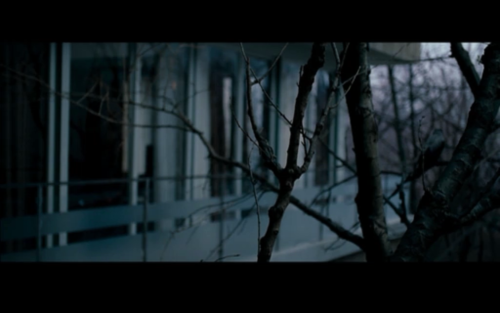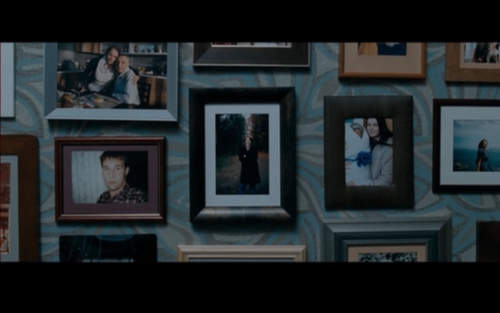
Elena‘s opening shot recalls Silent Light, with its real-time exploration of daybreak. In Elena we aren’t privileged with movement though. We sit still, among the branches of a wintry tree. However, Elena‘s opening does have an element of travel. There’s a slow rack-focus going on, creeping through the branches, so that over time, as more light filters into the world, we are forced to look deeper and deeper, through the branches. A crow eventually comes into sharp focus. This traveling may or may not be analogous to the tracking forward in Silent Light.
Either way, the world wakes up before Elena does.
“Shoot this film in black and white and cast Barbara Stanwyck as Elena, and you’d have a 1940s classic.” (Ebert) Well, not exactly. The tendency towards a Cinema of Contemplation has again changed everything. Here we monitor Elena’s waking with an objective stillness that recalls neorealism, while at the same time completely uprooting it. This is not dead time, but reclaimed time.
What we can say about the neorealism connection in Elena is that the camera’s voice seems forfeited. The aesthetic might be composed but it’s not really admirable, because it’s not mobilized to any particular end except “reporting.” It’s not crazy to ask for more from a film like Elena. It’s already got the Philip Glass score in there, driving at some sort of commentary. Especially given the first shot, there seems to be some sort of longing to communicate-via-camera.
But mostly we just get the variety of wide shots that leave details intentionally obscured, so that it takes some time to figure out who’s thinking what (facially.) And all of this without stretching into the kind of durational-endurance territory necessary for solid contemplation.
Although: as the film boils on, the cinematography does begin to communicate the sterile insulation of wealth. There’s melancholy to the blue gray cleanliness, the shine of everything in Elena’s husband’s home. Especially his car: a too-clean generic thing that successfully tucks its master away from the world, where he can switch manically between classical and bluesy-rock radio.
We can also see here a pleasant commitment (increasingly common) to selecting the focus of a sequence and holding that focus. You can see the tendency, and you want it to work, but there’s no commitment in Elena to this style of commitment. The trouble is this movie is never as radical as its, I’ll admit, difficult-to-pin-down posturing. (You do get the sense the film wants to be radical, although I’m not sure how. It might be Elena’s preoccupations with class that give the game away.)
It has to be said: the commitment to charting routine, and even, more trickily, filming extraordinary events methodically, bit by bit, as if they were a part of quite ordinary routines, begins to pay dividends right away.
The gym provides a place for Elena’s husband to engage artificial problems with simple solutions: the treadmill.
Another admirable thing about Elena:its great breadth. Hiking into the film’s world, you realize how constrained much of contemporary film is in its exploration of a few conventionally interesting cinematic spaces in the lives, or adventures, of its characters. The spaces explored in Elena are ordinary, but the filmmakers handle each with equal attention, so that we see the characters move through gymnasiums and churches and hospitals and homes in scenes that usually consist of normalcy, with a single signature twist of irony, or jolting comment. It’s an effective mechanism for reaching even a jaded viewer. We learn that we don’t know what’s going on. And when things are as complex as the real and ordinary world, they can take 110 minutes (easily) to understand.
The screenplay alternates between quiet mystery and fast-paced narrative gameplay. One fun example of the latter is a father daughter scene, in which a character is colored as suffering from a chronic inability to do anything but hungrily consume. “Drugs and alcohol only on the weekends,” she says, but we learn that she lives off the support of a hardly reluctant father whom she hates. She’s always seen hungrily smoking.
Troublingly, the quest for prettiness seems to have left the low-class, no-income household, well… easy on the eyes at best, and desirably cozy at worst. Since there’s a lot of thematic resonance riding on the contrast between high-income insulated living and low-class needy living, this is actually a big problem.
The film consistently devotes its attention to the coming and going of light, with entire sequences devoted to the switching on and switching off of indoor lights, and the shutting out or letting in of natural light. Curtains and fluorescents.
The low-income family the film tentatively works to build sympathy for, is interestingly unsympathetic. The potbellied dad (Elena’s son) walks about demanding beer and playing video games with his slacker son.
Finally, the most interesting thing about Elena might just be its strangely conservative politics, framing the low-income family as a bunch of moochers, sustained only by the willing violence of the titular character. Were it not for her risk, her amorality, and her charity, they might starve in their own laziness before, the film suggests, they would seek employment. If there’s an irony to this, a more nuanced statement about the paralyzed low-income strata of contemporary Moscow— it’s lost on me. Even the film’s final showpiece arrives as a scene from another film completely.
I didn’t understand this film.
-Max Berwald

